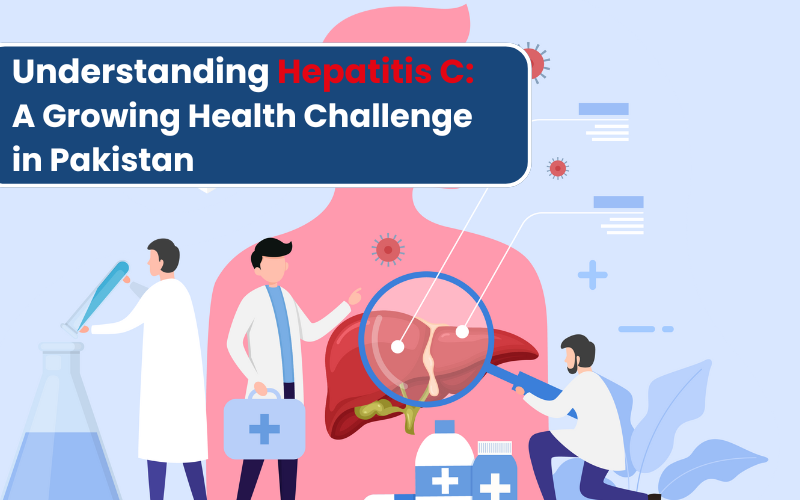Hepatitis, a term meaning inflammation of the liver, encompasses several viral infections that attack this vital organ. While sharing similar symptoms, each type has distinct causes, transmission methods, and long-term implications. Hepatitis viruses are classified from A through E, with Hepatitis C (HCV) presenting one of the most significant public health challenges globally, particularly in Pakistan.
Types of Hepatitis
Hepatitis A typically spreads through contaminated food or water and causes acute infection with complete recovery in most cases.
Hepatitis B transmits through blood, bodily fluids, and from mother to child during birth. It can cause both acute and chronic disease.
Hepatitis C primarily spreads through blood contact and frequently becomes a chronic condition with serious complications.
Hepatitis D only occurs alongside Hepatitis B infection, creating a more severe combined disease.
Hepatitis E transmits through contaminated water and is usually self-limiting, though it can be dangerous for pregnant women.
Symptoms and Health Effects of Hepatitis C
Hepatitis C often progresses silently, which is why it’s sometimes called a “silent epidemic.” Many infected individuals remain asymptomatic for decades while liver damage gradually accumulates.
When symptoms do appear, they typically include:
– Persistent fatigue
– Jaundice (yellowing of skin and eyes)
– Abdominal pain, particularly in the upper right quadrant
– Nausea and reduced appetite
– Joint and muscle pain
– Unexplained weight loss
– Cognitive symptoms including depression and brain fog
Without treatment, chronic HCV infection can lead to serious complications including liver fibrosis, cirrhosis, liver failure, and hepatocellular carcinoma (liver cancer). These complications develop in approximately 20-30% of chronically infected individuals over a period of 20-30 years.
Causes and Transmission
Hepatitis C virus transmits exclusively through blood-to-blood contact. In Pakistan, the main transmission routes include:
- Healthcare-related exposures: Reuse of syringes and needles, inadequate sterilization of medical equipment, and unsafe blood transfusions constitute the primary transmission pathway.
- Community practices: Traditional barbering with shared razors, tattooing, ear/nose piercing, and other procedures involving non-sterile instruments contribute significantly to transmission.
- Household contact: Sharing personal items like toothbrushes or razors that may have blood contamination presents another risk factor.
Unlike some other hepatitis viruses, HCV is not spread through food, water, casual contact, breastfeeding, or sexual contact (though the latter is possible in rare circumstances).
What to Do If You Suspect Infection
If you experience symptoms consistent with hepatitis or have risk factors for exposure, seeking prompt medical evaluation is essential. The diagnostic process typically involves:
- Initial screening: A simple blood test can detect HCV antibodies, indicating exposure to the virus.
- Confirmation: Positive antibody tests require confirmation with HCV RNA testing to determine if active infection exists.
- Additional assessment: If active infection is confirmed, your healthcare provider will likely recommend liver function tests, viral load measurement, and possibly genotype testing to guide treatment decisions.
Early diagnosis is crucial, as modern direct-acting antiviral (DAA) treatments can cure over 95% of HCV infections with minimal side effects, preventing progression to serious liver disease.
Prevalence in Pakistan
Pakistan bears the second highest burden of Hepatitis C globally. Current epidemiological data indicates that approximately 9.7 million Pakistanis live with active HCV infection, representing a national prevalence rate of 4.3%—nearly ten times the global average.
The prevalence varies significantly by region, with some provinces reporting rates as high as 8%. Rural areas generally show higher infection rates than urban centers, reflecting disparities in healthcare access and infection control practices.
This high disease burden places enormous strain on Pakistan’s healthcare system and economy through direct treatment costs and productivity losses from chronic illness.
Prevention and Protection
Preventing HCV transmission requires multi-level interventions:
Individual-level prevention:
– Avoid unnecessary medical injections and ensure new, sealed syringes for necessary ones
– Verify blood safety before transfusions when possible
– Use licensed practitioners for procedures like tattooing or piercing
– Avoid sharing personal items that might have blood contact
– Request disposable or properly sterilized instruments at barber shops
Healthcare-level interventions:
– Implementation of proper infection control protocols
– Use of auto-disable syringes to prevent reuse
– Comprehensive blood donor screening
Public health approaches:
– Community education about transmission risks
– Access to screening programs for early detection
– Treatment availability to reduce the infected population and prevent further transmission
With appropriate awareness, preventive measures, and prompt treatment, Pakistan can work toward reducing its substantial Hepatitis C burden. Increased knowledge and vigilance at both individual and systemic levels remain the most powerful tools in combating this widespread but preventable disease.



